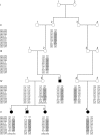A novel susceptibility locus for Hirschsprung's disease maps to 4q31.3-q32.3
- PMID: 16816022
- PMCID: PMC2564564
- DOI: 10.1136/jmg.2005.038125
A novel susceptibility locus for Hirschsprung's disease maps to 4q31.3-q32.3
Abstract
We report on a multigenerational family with isolated Hirschsprung's disease (HSCR). Five patients were affected by either short segment or long segment HSCR. The family consists of two main branches: one with four patients (three siblings and one maternal uncle) and one with one patient. Analysis of the RET gene, the major gene involved in HSCR susceptibility, revealed neither linkage nor mutations. A genome wide linkage analysis was performed, revealing suggestive linkage to a region on 4q31-q32 with a maximum parametric multipoint LOD score of 2.7. Furthermore, non-parametric linkage (NPL) analysis of the genome wide scan data revealed a NPL score of 2.54 (p = 0.003) for the same region on chromosome 4q (D4S413-D4S3351). The minimum linkage interval spans a region of 11.7 cM (12.2 Mb). No genes within this chromosomal interval have previously been implicated in HSCR. Considering the low penetrance of disease in this family, the 4q locus may be necessary but not sufficient to cause HSCR in the absence of modifying loci elsewhere in the genome. Our results suggest the existence of a new susceptibility locus for HSCR at 4q31.3-q32.3.
Conflict of interest statement
Competing interests: there are no competing interests
Similar articles
-
Long segment and short segment familial Hirschsprung's disease: variable clinical expression at the RET locus.J Med Genet. 1994 Aug;31(8):602-6. doi: 10.1136/jmg.31.8.602. J Med Genet. 1994. PMID: 7815416 Free PMC article.
-
A review of genetic mutation in familial Hirschsprung's disease in South Africa: towards genetic counseling.J Pediatr Surg. 2008 Feb;43(2):325-9. doi: 10.1016/j.jpedsurg.2007.10.021. J Pediatr Surg. 2008. PMID: 18280283
-
Identification of Variants in RET and IHH Pathway Members in a Large Family With History of Hirschsprung Disease.Gastroenterology. 2018 Jul;155(1):118-129.e6. doi: 10.1053/j.gastro.2018.03.034. Epub 2018 Mar 28. Gastroenterology. 2018. PMID: 29601828
-
Comprehensive characterization of the genetic landscape of familial Hirschsprung's disease.World J Pediatr. 2023 Jul;19(7):644-651. doi: 10.1007/s12519-023-00686-x. Epub 2023 Mar 1. World J Pediatr. 2023. PMID: 36857021 Free PMC article. Review.
-
Advances in molecular genetics of Hirschsprung's disease.Anat Rec (Hoboken). 2012 Oct;295(10):1628-38. doi: 10.1002/ar.22538. Epub 2012 Jul 19. Anat Rec (Hoboken). 2012. PMID: 22815266 Review.
Cited by
-
Building a brain in the gut: development of the enteric nervous system.Clin Genet. 2013 Apr;83(4):307-16. doi: 10.1111/cge.12054. Epub 2012 Nov 27. Clin Genet. 2013. PMID: 23167617 Free PMC article. Review.
-
Exome-Wide Association Study Identified New Risk Loci for Hirschsprung's Disease.Mol Neurobiol. 2017 Apr;54(3):1777-1785. doi: 10.1007/s12035-016-9752-2. Epub 2016 Feb 18. Mol Neurobiol. 2017. PMID: 26887379
-
Symptomatology, pathophysiology, diagnostic work-up, and treatment of Hirschsprung disease in infancy and childhood.Curr Gastroenterol Rep. 2007 Jun;9(3):245-53. doi: 10.1007/s11894-007-0026-z. Curr Gastroenterol Rep. 2007. PMID: 17511924 Review.
-
Genome-wide copy number analysis uncovers a new HSCR gene: NRG3.PLoS Genet. 2012;8(5):e1002687. doi: 10.1371/journal.pgen.1002687. Epub 2012 May 10. PLoS Genet. 2012. PMID: 22589734 Free PMC article.
-
Mutational spectrum of semaphorin 3A and semaphorin 3D genes in Spanish Hirschsprung patients.PLoS One. 2013;8(1):e54800. doi: 10.1371/journal.pone.0054800. Epub 2013 Jan 23. PLoS One. 2013. PMID: 23372769 Free PMC article.
References
-
- Puri P. Hirschsprung's disease: Clinical Generalities. In: Holschneider A, ed. Hirschsprung's disease. 2nd ed. Amsterdam: Harwood Academic Publishers, 2000129–135.
-
- Romeo G, Ronchetto P, Luo Y, Barone V, Seri M, Ceccherini I, Pasini B, Bocciardi R, Lerone M, Kaariainen H, Martucciello G. Point mutations affecting the tyrosine kinase domain of the RET proto‐oncogene in Hirschsprung's disease. Nature 1994367377–378. - PubMed
-
- Edery P, Lyonnet S, Mulligan L M, Pelet A, Dow E, Abel L, Holder S, Nihoul‐Fekete C, Ponder B A, Munnich A. Mutations of the RET proto‐oncogene in Hirschsprung's disease. Nature 1994367378–380. - PubMed
-
- Angrist M, Bolk S, Halushka M, Lapchak P A, Chakravarti A. Germline mutations in glial cell line‐derived neurotrophic factor (GDNF) and RET in a Hirschsprung disease patient. Nat Genet 199614341–344. - PubMed
Publication types
MeSH terms
Substances
LinkOut - more resources
Full Text Sources
Miscellaneous


